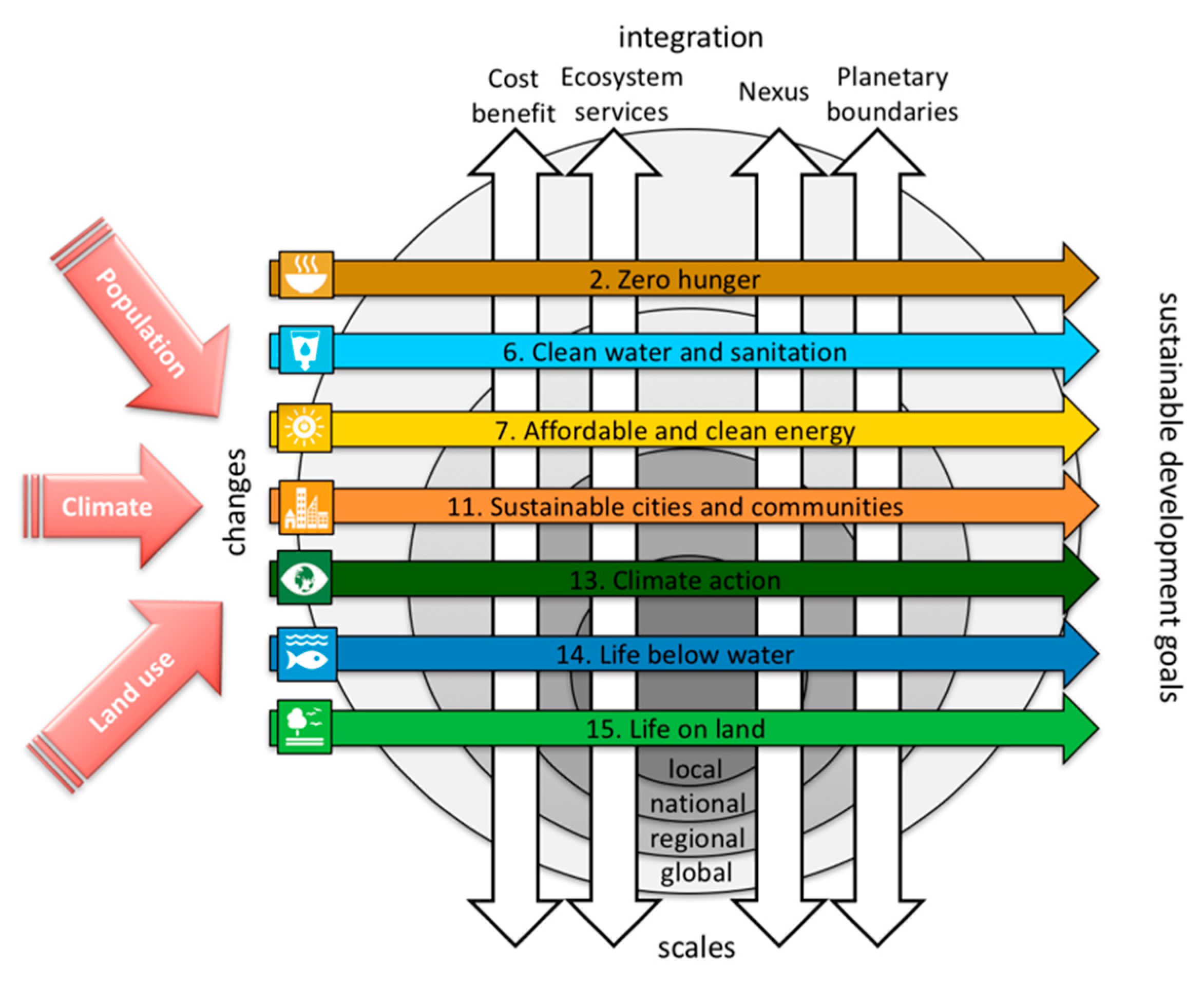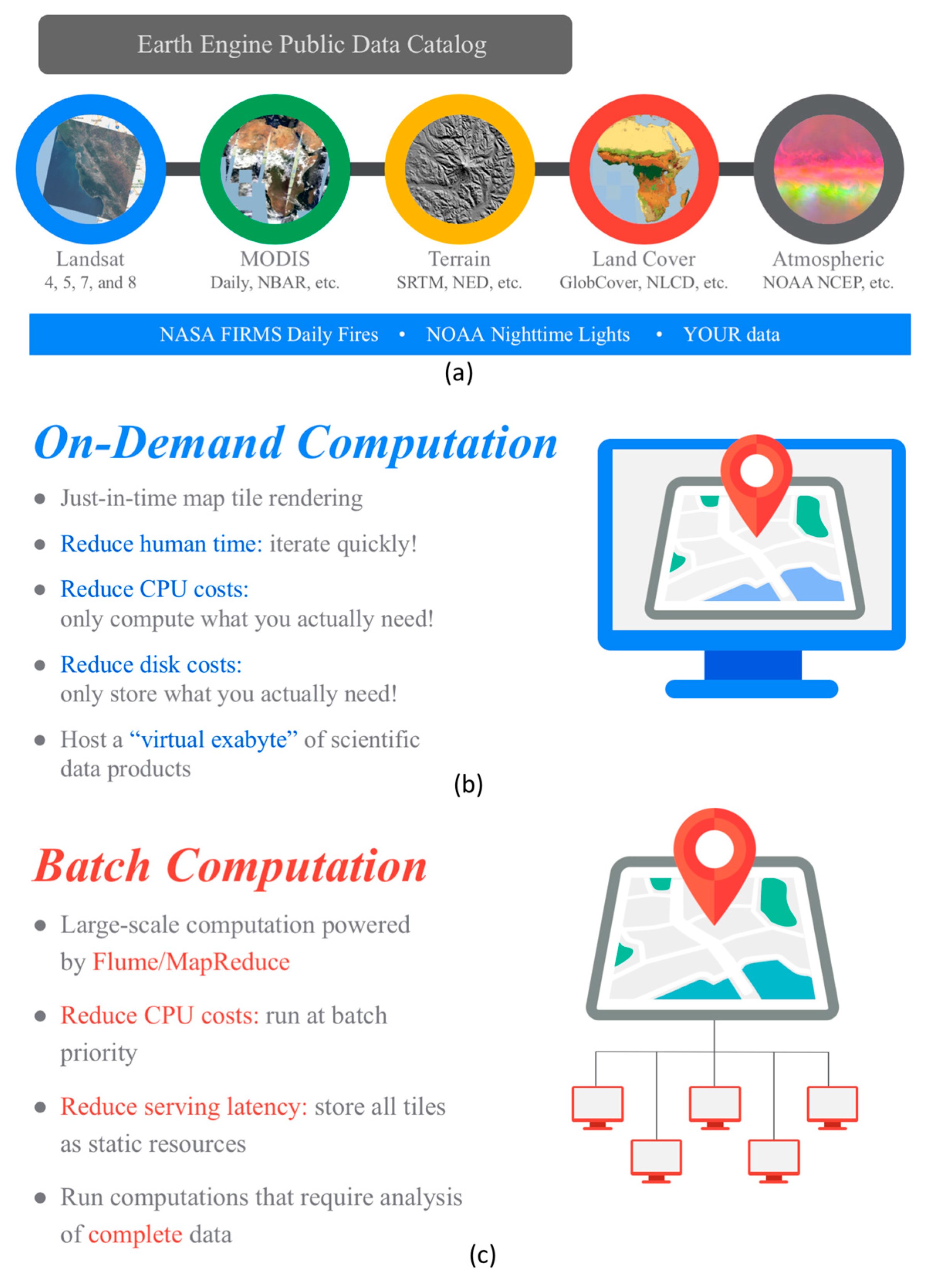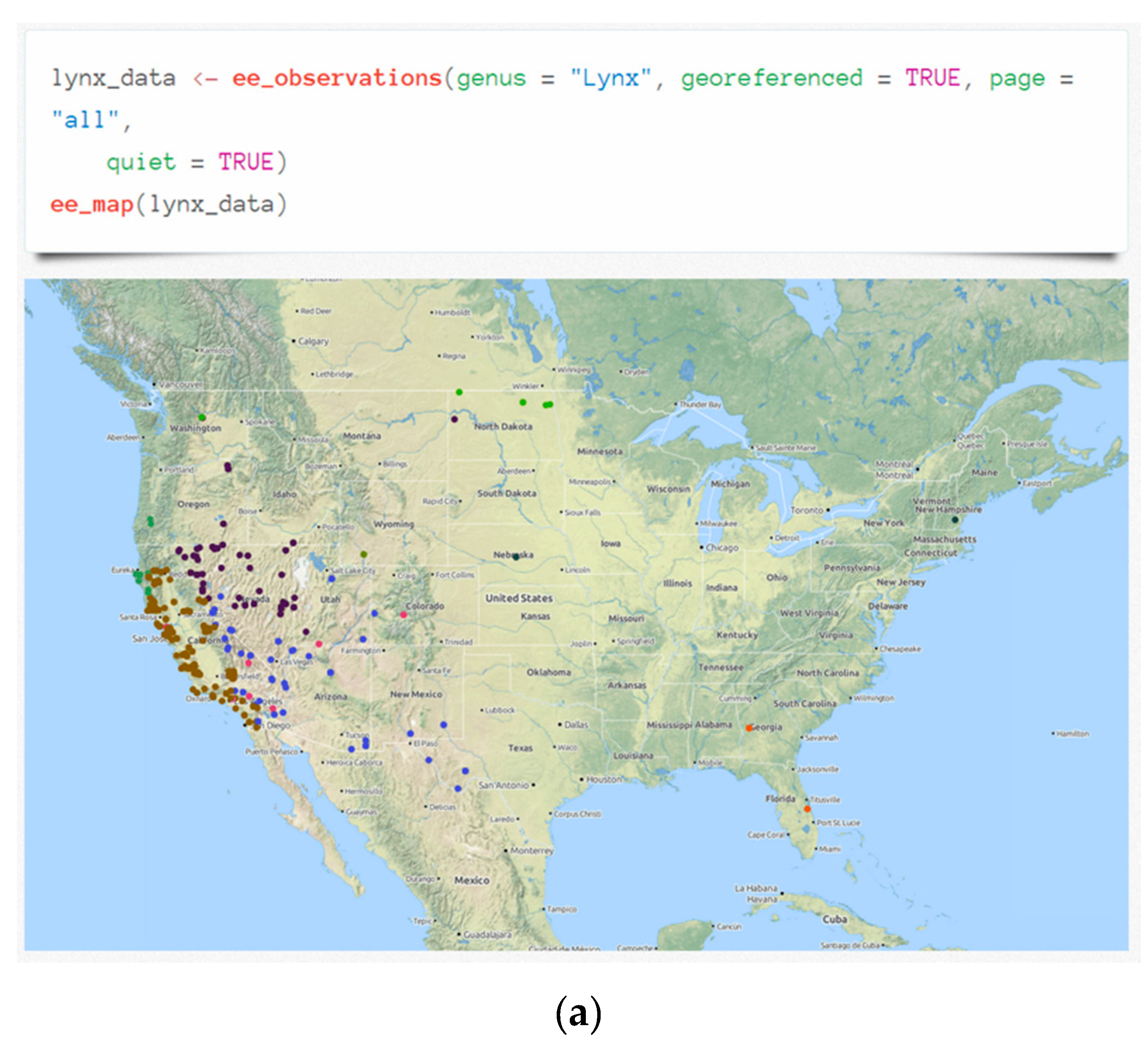Lifting the Information Barriers to Address Sustainability Challenges with Data from Physical Geography and Earth Observation
Abstract
:1. Introduction
- User access to data is limited and can be improved by data sharing based on web platforms and interoperability in order to facilitate the use and reuse of high-quality data on the environment.
- The increasing size and complexity of data sources can be handled by improved data-processing capacities in order to make better sense of the amount of data confronting decision makers.
- Individual software solutions can be improved by the ability to elaborate and iterate on and between them. Data processing, analysis, and reporting workflows can be enhanced by developing application programming interfaces (APIs) for software products in order to enhance third-party development without duplicated efforts.
- Limited knowledge transmission and uptake can be enhanced through collaborative engagement, co-creating and applying scientific decision-support tools in order to identify solutions to problems faced by specific stakeholders.
2. Materials and Methods
2.1. Limited Access to Data
2.2. Increasing Size and Complexity of Data
2.3. Ability to Elaborate on Software Solutions
2.4. Knowledge Transmission
3. Results from Selected Case Studies and Discussion
3.1. Data Sharing in the Black Sea Catchment
3.2. Addressing Size and Complexity with Google Earth Engine
3.3. Accessing Biological and Geospatial Data from APIs
3.4. Transferring Knowledge through Participatory Approaches
4. General Discussion
5. Conclusions
- Interoperability (A) is the most important quality for improving accessibility to data, and this can be achieved through standardized protocols, data harmonization, and a sharing culture.
- Scalability (B) is the most important quality for improving the ability to process data, and this can be achieved through grid computing.
- Openness (C) is the most important quality for improving the ability to convey results, and this can be achieved through APIs.
- Collaboration (D) is the most important quality for improving discussion among and between the public, scientists, and decision-makers.
Acknowledgments
Author Contributions
Conflicts of Interest
References
- UN. Transforming Our World: The 2030 Agenda for Sustainable Development. Available online: https://sustainabledevelopment.un.org/post2015/transformingourworld/publication (accessed on 5 May 2017).
- Scott, G.; Rajabifard, A. Integrating geospatial information Sustainable Development Goals. In Proceedings of the Twentieth United Nations Regional Cartographic Conference for Asia and the Pacific, Jeju Island, Korea, 6–9 October 2015. [Google Scholar]
- Brooks, T.M.; Butchart, S.H.M.; Cox, N.A.; Heath, M.; Hilton-Taylor, C.; Hoffmann, M.; Kingston, N.; Rodríguez, J.P.; Stuart, S.N.; Smart, J. Harnessing biodiversity and conservation knowledge products to track the Aichi Targets and Sustainable Development Goals. Biodiversity 2015, 16, 157–174. [Google Scholar] [CrossRef]
- CBD. Global Biodiversity Outlook 4. Available online: https://www.cbd.int/gbo/gbo4/publication/gbo4-en.pdf (accessed on 5 May 2017).
- Scholes, R.J.; Walters, M.; Turak, E.; Saarenmaa, H.; Heip, C.H.R.; Tuama, E.O.; Faith, D.P.; Mooney, H.A.; Ferrier, S.; Jongman, R.H.G.; et al. Building a global observing system for biodiversity. Curr. Opin. Environ. Sustain. 2012, 4, 139–146. [Google Scholar] [CrossRef]
- Pereira, H.M.; Ferrier, S.; Walters, M.; Geller, G.N.; Jongman, R.H.G.; Scholes, R.J.; Bruford, M.W.; Brummitt, N.; Butchart, S.H.M.; Cardoso, A.C.; et al. Essential Biodiversity Variables. Science 2013, 339, 277–278. [Google Scholar] [CrossRef] [PubMed]
- Kissling, W.D.; Hardisty, A.; García, E.A.; Santamaria, M.; De Leo, F.; Pesole, G.; Freyhof, J.; Manset, D.; Wissel, S.; Konijn, J.; et al. Towards global interoperability for supporting biodiversity research on essential biodiversity variables (EBVs). Biodiversity 2015, 16, 99–107. [Google Scholar] [CrossRef]
- UN. A World That Count; Independent Expert Advisory Group on a Data Revolution for Sustainable Development. Available online: http://www.undatarevolution.org/wp-content/uploads/2014/11/A-World-That-Counts.pdf (accessed on 10 May 2017).
- Lu, Y.L.; Nakicenovic, N.; Visbeck, M.; Stevance, A.S. Five priorities for the UN Sustainable Development Goals. Nature 2015, 520, 432–433. [Google Scholar] [CrossRef] [PubMed]
- Steffen, W.; Richardson, K.; Rockstrom, J.; Cornell, S.E.; Fetzer, I.; Bennett, E.M.; Biggs, R.; Carpenter, S.R.; de Vries, W.; de Wit, C.A.; et al. Planetary boundaries: Guiding human development on a changing planet. Science 2015, 347, 736–748. [Google Scholar] [CrossRef] [PubMed]
- IPCC. Climate Change 2014: Synthesis Report; Contribution of Working Groups I, II and III to the Fifth Assessment Report of the Intergovernmental Panel on Climate Change; IPCC: Geneva, Switzerland, 2014. [Google Scholar]
- Pouzols, F.M.; Toivonen, T.; Di Minin, E.; Kukkala, A.S.; Kullberg, P.; Kuustera, J.; Lehtomaki, J.; Tenkanen, H.; Verburg, P.H.; Moilanen, A. Global protected area expansion is compromised by projected land-use and parochialism. Nature 2014, 516, 383–386. [Google Scholar] [CrossRef] [PubMed]
- Samways, M.J.; Bazelet, C.S.; Pryke, J.S. Provision of ecosystem services by large scale corridors and ecological networks. Biodivers. Conserv. 2010, 19, 2949–2962. [Google Scholar] [CrossRef]
- UN. Population 2030: Demographic Challenges and Opportunities for Sustainable Development Planning; United Nation: New York, NY, USA, 2015. [Google Scholar]
- Giuliani, G.; Ray, N.; Schwarzer, S.; De Bono, A.; Peduzzi, P.; Dao, H.; Van Woerden, J.; Witt, R.; Beniston, M.; Lehmann, A. Sharing Environmental Data through GEOSS. Int. J. Appl. Geospat. Res. 2011, 2, 1–17. [Google Scholar] [CrossRef]
- Stone, R. Earth-Observation Summit Endorses Global Data Sharing. Science 2010, 330, 902. [Google Scholar] [CrossRef] [PubMed]
- Nogueras-Iso, J.; Zarazaga-Soria, F.J.; Bejar, R.; Alvarez, P.J.; Muro-Medrano, P.R. OGC Catalog services: A key element for the development of Spatial Data Infrastructures. Comput. Geosci. 2005, 31, 199–209. [Google Scholar] [CrossRef]
- Open Source Geospatial Content Management System. Available online: http://geonode.org/ (accessed on 5 May 2017).
- Giuliani, G.; Lacroix, P.; Guigoz, Y.; Roncella, R.; Bigagli, L.; Santoro, M.; Mazzetti, P.; Nativi, S.; Ray, N.; Lehmann, A. Bringing GEOSS Services into Practice: A Capacity Building Resource on Spatial Data Infrastructures (SDI). Available online: http://onlinelibrary.wiley.com/doi/10.1111/tgis.12209/epdf (accessed on 5 May 2017).
- Rodila, D.; Gorgan, D. Geospatial and Grid Interoperability Through OGC Services Gridification. IEEE J. Sel. Top. Appl. Observ. Remote Sens. 2012, 5, 1650–1658. [Google Scholar] [CrossRef]
- Google Earth Engine. Available online: https://earthengine.google.com/ (accessed on 5 May 2017).
- Search the Largest API Directory on the Web. Available online: http://www.programmableweb.com/category/environment/apis?keyword=environment (accessed on 5 May 2017).
- GDAL—Geospatial Data Abstraction Library. Available online: http://www.gdal.org/ (accessed on 5 May 2017).
- Koy, K. Berkeley Ecoinformatics Engine. In Proceedings of the AAAS 2015 Annual Meeting, San Jose, CA, USA, 12–16 February 2015. [Google Scholar]
- Berkeley Ecoinformatics Engine. An Open API Serving UC Berkeley’s Natural History Data. Available online: https://ecoengine.berkeley.edu/ (accessed on 5 May 2017).
- Cash, D.W.; Clark, W.C.; Alcock, F.; Dickson, N.M.; Eckley, N.; Guston, D.H.; Jäger, J.; Mitchell, R.B. Knowledge systems for sustainable development. Proc. Natl. Acad. Sci. USA 2003, 100, 8086–8091. [Google Scholar] [CrossRef] [PubMed]
- Rosenthal, A.; Verutes, G.; McKenzie, E.; Arkema, K.K.; Bhagabati, N.; Bremer, L.L.; Olwero, N.; Vogl, A.L. Process matters: A framework for conducting decision-relevant assessments of ecosystem services. Int. J. Biodivers. Sci. Ecosyst. Serv. Manag. 2015, 11, 190–204. [Google Scholar] [CrossRef]
- SeaSketch Supports Collaborative Planning for Our Oceans. Available online: http://seasketch.org/ (accessed on 5 May 2017).
- InVEST—Integrating Valuation of Ecosystem Services and Tradeoffs. Available online: http://naturalcapitalproject.org/invest (accessed on 5 May 2017).
- RIOS. Optimizing Cost-Effective Investments for Clean Water and Other Benefits. Available online: http://www.naturalcapitalproject.org/software/rios (accessed on 5 May 2017).
- Lehmann, A.; Giuliani, G.; Mancosu, E.; Abbaspour, K.C.; Soezen, S.; Gorgan, D.; Beel, A.; Ray, N. Filling the gap between Earth observation and policy making in the Black Sea catchment with enviroGRIDS. Environ. Sci. Policy 2015, 46, 1–12. [Google Scholar] [CrossRef]
- Mancosu, E.; Gago-Silva, A.; Barbosa, A.; de Bono, A.; Ivanov, E.; Lehmann, A.; Fons, J. Future land-use change scenarios for the Black Sea catchment. Environ. Sci. Policy 2015, 46, 26–36. [Google Scholar] [CrossRef]
- Rouholahnejad, E.; Abbaspour, K.C.; Srinivasan, R.; Bacu, V.; Lehmann, A. Water resources of the Black Sea Basin at high spatial and temporal resolution. Water Resour. Res. 2014, 50, 5866–5885. [Google Scholar] [CrossRef]
- Bar, R.; Rouholahnedjad, E.; Rahman, K.; Abbaspour, K.C.; Lehmann, A. Climate change and agricultural water resources: A vulnerability assessment of the Black Sea catchment. Environ. Sci. Policy 2015, 46, 57–69. [Google Scholar] [CrossRef]
- Fasel, M.; Brethaut, C.; Rouholahnejad, E.; Lacayo-Emery, M.A.; Lehmann, A. Blue water scarcity in the Black Sea catchment: Identifying key actors in the water-ecosystem-energy-food nexus. Environ. Sci. Policy 2016, 66, 140–150. [Google Scholar] [CrossRef]
- EnviroGRIDS. Core Datasets. Available online: http://blacksea.grid.unep.ch/ (accessed on 5 May 2017).
- Lehmann, A.; Giuliani, G.; Ray, N.; Rahman, K.; Abbaspour, K.C.; Nativi, S.; Craglia, M.; Cripe, D.; Quevauviller, P.; Beniston, M. Reviewing innovative Earth observation solutions for filling science-policy gaps in hydrology. J. Hydrol. 2014, 518, 267–277. [Google Scholar] [CrossRef]
- Giuliani, G.; Ray, N.; Lehmann, A. Building Regional Capacities for GEOSS and INSPIRE: A journey in the Black Sea Catchment. Int. J. Adv. Comput. Sci. Appl. 2013, 3, 19–27. [Google Scholar] [CrossRef]
- Nativi, S.; Craglia, M.; Pearlman, J. Earth Science Infrastructures Interoperability: The Brokering Approach. IEEE J. Sel. Top. Appl. Obs. Remote Sens. 2013, 6, 1118–1129. [Google Scholar] [CrossRef]
- Gorgan, D.; Bacu, V.; Mihon, D.; Stefanut, T.; Rodila, D.; Cau, P.; Abbaspour, K.; Giuliani, G.; Ray, N.; Lehmann, A. Software Platform Interoperability Throughout EnviroGRIDS Portal. IEEE J. Sel. Top. Appl. Observ. Remote Sens. 2012, 5, 1617–1627. [Google Scholar] [CrossRef]
- Giuliani, G.; Nativi, S.; Lehmann, A.; Ray, N. WPS mediation: An approach to process geospatial data on different computing backends. Comput. Geosci. 2012, 47, 20–33. [Google Scholar] [CrossRef]
- Castronova, A.M.; Goodall, J.L.; Elag, M.M. Models as web services using the Open Geospatial Consortium (OGC) Web Processing Service (WPS) standard. Environ. Model. Softw. 2013, 41, 72–83. [Google Scholar] [CrossRef]
- Dubois, G.; Schulz, M.; Skoien, J.; Bastin, L.; Peedell, S. eHabitat, a multi-purpose Web Processing Service for ecological modeling. Environ. Model. Softw. 2013, 41, 123–133. [Google Scholar] [CrossRef]
- NASA Global Change Master Directory. Available online: https://gcmd.nasa.gov/ (accessed on 5 May 2017).
- Giuliani, G.; Peduzzi, P. The PREVIEW Global Risk Data Platform: A geoportal to serve and share global data on risk to natural hazards. Nat. Hazards Earth Syst. Sci. 2011, 11, 53–66. [Google Scholar] [CrossRef]
- Global Risk Data Platform. Available online: http://preview.grid.unep.ch/ (accessed on 5 May 2017).
- Water Information System for Europe. Available online: http://water.europa.eu/ (accessed on 5 May 2017).
- Hansen, J.; Kharecha, P.; Sato, M.; Masson-Delmotte, V.; Ackerman, F.; Beerling, D.J.; Hearty, P.J.; Hoegh-Guldberg, O.; Hsu, S.L.; Parmesan, C.; et al. Assessing “Dangerous Climate Change”: Required Reduction of Carbon Emissions to Protect Young People, Future Generations and Nature. PLoS ONE 2013, 8, e81648. [Google Scholar] [CrossRef] [PubMed]
- Patel, N.N.; Angiuli, E.; Gamba, P.; Gaughan, A.; Lisini, G.; Stevens, F.R.; Tatem, A.J.; Trianni, G. Multitemporal settlement and population mapping from Landsat using Google Earth Engine. Int. J. Appl. Earth Obs. Geoinf. 2015, 35, 199–208. [Google Scholar] [CrossRef]
- Alonso, A.; Munoz-Carpena, R.; Kennedy, R.E.; Murcia, C. Wetland Landscape Spatio-Temporal Degradation Dynamics Using the New Google Earth Engine Cloud-Based Platform: Opportunities for Non-Specialists in Remote Sensing. Trans. ASABE 2016, 59, 1333–1344. [Google Scholar]
- Shelestov, A.; Lavreniuk, M.; Kussul, N.; Novikov, A.; Skakun, S. Exploring Google Earth Engine Platform for Big Data Processing: Classification of Multi-Temporal Satellite Imagery for Crop Mapping. Front. Earth Sci. 2017, 5, 1–10. [Google Scholar] [CrossRef]
- Mateescu, G.; Gentzsch, W.; Ribbens, C.J. Hybrid Computing-Where HPC meets grid and Cloud Computing. Future Gener. Comput. Syst. 2011, 27, 440–453. [Google Scholar] [CrossRef]
- Hajibaba, M.; Gorgin, S. A Review on Modern Distributed Computing Paradigms: Cloud Computing, Jungle Computing and Fog Computing. J. Comput. Inf. Technol. 2014, 22, 69–84. [Google Scholar] [CrossRef]
- GIS Cloud. Real-Time Mapping Platform for the Entire Workflow of Your Organization. Available online: http://www.giscloud.com/ (accessed on 5 May 2017).
- Evangelidis, K.; Ntouros, K.; Makridis, S.; Papatheodorou, C. Geospatial services in the Cloud. Comput. Geosci. 2014, 63, 116–122. [Google Scholar] [CrossRef]
- Holos Berkeley Ecoinformatics Engine. Available online: https://holos.berkeley.edu/resources/code-examples (accessed on 5 May 2017).
- Kao, M.C.J.; Gesmann, M.; Gheri, F. Download Data from the FAOSTAT Database of the Food and Agricultural Organization (FAO) of the United Nations; FAO: Roma, Italy, 2015. [Google Scholar]
- GEODAB—GEO Discovery and Access Broker. Available online: http://www.geodab.net/ (accessed on 5 May 2017).
- NASA API Portal. Available online: https://api.nasa.gov/ (accessed on 5 May 2017).
- Merrifield, M.S.; McClintockb, W.; Burtb, C.; Foxc, E.; Serpad, P.; Steinbacke, C.; Gleasona, M. MarineMap: A web-based platform for collaborative marine protected area planning. Ocean Coast. Manag. 2013, 74, 67–76. [Google Scholar] [CrossRef]
- Cravens, A.E. Negotiation and Decision Making with Collaborative Software: How MarineMap ‘Changed the Game’ in California’s Marine Life Protected Act Initiative. Environ. Manag. 2015, 57, 1–24. [Google Scholar] [CrossRef] [PubMed]
- Sharp, R.; Tallis, H.T.; Ricketts, T.; Guerry, A.D.; Wood, S.A.; Chaplin-Kramer, R.; Nelson, E.; Ennaanay, D.; Wolny, S.; Olwero, N.; et al. InVEST 3.2.0 User’s Guide; Stanford Woods Institute for the Environment: Stanford, CA, USA, 2015. [Google Scholar]
- Ruckelshaus, M.; McKenzie, E.; Tallis, H.; Guerry, A.; Daily, G.; Kareiva, P.; Polasky, S.; Ricketts, T.; Bhagabati, N.; Wood, S.A.; et al. Notes from the field: Lessons learned from using ecosystem service approaches to inform real-world decisions. Ecol. Econ. 2015, 115, 11–21. [Google Scholar] [CrossRef]
- Goldman-Benner, R.L.; Benitez, S.; Boucher, T.; Calvache, A.; Daily, G.; Kareiva, P.; Kroeger, T.; Ramos, A. Water funds and payments for ecosystem services: practice learns from theory and theory can learn from practice. Oryx 2012, 46, 55–63. [Google Scholar] [CrossRef]
- Bremer, L.; Auerbach, D.A.; Goldstein, J.H.; Vogl, A.L.; Shemie, D.; Nelson, J.L.; Kroeger, T.; Benítez, S.P.; Calvache, A.; Guimarães, J.; et al. One size does not fit all: Diverse approaches to natural infrastructure investments within the Latin American Water Funds Partnership. Ecosyst. Serv. 2016, 17, 217–236. [Google Scholar] [CrossRef]
- Vogl, A.L.; Tallis, H.; Douglass, J.; Sharp, R.; Wolny, S.; Veiga, F.; Benitez, S.; León, J.; Game, E.; Petry, P.; et al. A Resource Investment Optimization System: Introduction & Theoretical Documentation; Stanford University: Stanford, CA, USA, 2015; p. 76. [Google Scholar]
- OpenStreetMap. Available online: http://www.openstreetmap.org/ (accessed on 5 May 2017).
- MAP-X: Mapping and Assessing the Performance of Extractive Industries. Available online: http://www.mapx.io/ (accessed on 5 May 2017).
- Shiny—Easy Web Applications in R. Available online: http://www.rstudio.com/products/shiny (accessed on 5 May 2017).
- Stamatian, F.; Baba, C.O.; Timofe, M.P. Barriers in the Implementation of Health Information Systems: A Scoping Review. Transylv. Rev. Adm. Sci. 2013, 9, 156–173. [Google Scholar]
- Schwister, F.; Fiedler, M. What are the main barriers to smart energy information systems diffusion? Electron. Mark. 2015, 25, 31–45. [Google Scholar] [CrossRef]
- Rowley, J. The wisdom hierarchy: Representations of the DIKW hierarchy. J. Inf. Sci. 2007, 33, 163–180. [Google Scholar] [CrossRef]
- Rodila, D.; Ray, N.; Gorgan, D. Conceptual model for environmental science applications on parallel and distributed infrastructures. Environ. Syst. Res. 2015, 4, 23. [Google Scholar] [CrossRef]







© 2017 by the author. Licensee MDPI, Basel, Switzerland. This article is an open access article distributed under the terms and conditions of the Creative Commons Attribution (CC BY) license (http://creativecommons.org/licenses/by/4.0/).
Share and Cite
Lehmann, A.; Chaplin-Kramer, R.; Lacayo, M.; Giuliani, G.; Thau, D.; Koy, K.; Goldberg, G.; Jr., R.S. Lifting the Information Barriers to Address Sustainability Challenges with Data from Physical Geography and Earth Observation. Sustainability 2017, 9, 858. https://doi.org/10.3390/su9050858
Lehmann A, Chaplin-Kramer R, Lacayo M, Giuliani G, Thau D, Koy K, Goldberg G, Jr. RS. Lifting the Information Barriers to Address Sustainability Challenges with Data from Physical Geography and Earth Observation. Sustainability. 2017; 9(5):858. https://doi.org/10.3390/su9050858
Chicago/Turabian StyleLehmann, Anthony, Rebecca Chaplin-Kramer, Martin Lacayo, Grégory Giuliani, David Thau, Kevin Koy, Grace Goldberg, and Richard Sharp Jr. 2017. "Lifting the Information Barriers to Address Sustainability Challenges with Data from Physical Geography and Earth Observation" Sustainability 9, no. 5: 858. https://doi.org/10.3390/su9050858





